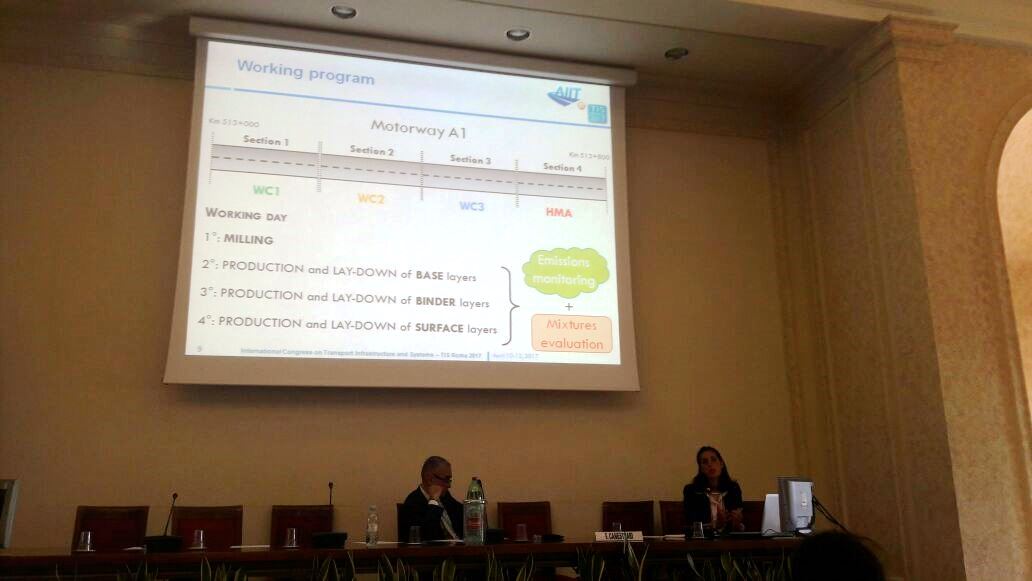TIS 2017
Session 3 – Sustainable Road Construction Practices

The third session of the TIS Congress, chaired by professor Francesco Canestrari, focused the problem of road construction sustainability presenting recent studies about the progress in low-impact technologies with and in depth analysis about the re-use of materials in road pavement construction and maintenance. A significant study about the cutting-edge technologies for energy harvesting completed the new perspective introduced during this session
Davide Lo Presti, Gordon Airey, Gaetano Di Mino, Maurizio Di Liberto, Anita Blasl, Gustavo Canon Falla and Frohmut Wellner – Allback2pave: towards a sustainable 100% recycling of reclaimed asphalt in road pavements / This work provides a summary of the main results of “AllBack2Pave 2013-2015” a two-years, 500K€ project funded by the CEDR Transnational Road Research project that evaluated the feasibility of going towards 100% recycling of asphalt pavements into surface courses. The main objectives were two-fold: 1) To establish, through laboratory tests on binders and asphalt mixes, whether the use of high rates of RA is feasible in developing mixes with a high level of durability. 2) To develop guidelines on how to best produce cost-effective and quality asphalt mixes with high RA content; 3) To measure the sustainability performance of the technologies with a novel practical holistic approach based on life-cycle thinking. The project, coordinated by the Technische Universität Dresden in Germany, together with the University of Nottingham and University of Palermo, was structured so to provide an overview of the European panorama by involving 3 EU countries.
Arianna Stimilli, Francesca Frigio, Stefano Sciolette and Francesco Canestrari – In-plant production of warm recycled mixtures produced with sbs modified bitumen: a case study / This research describes in-plant productions of warm recycled mixtures prepared with three chemical WMA additives for the construction of an extensive motorway segment. Three full-scale trial sections included warm mixtures whereas a further section, used as reference for comparison purposes, comprised analogous mixtures realized through hot recycling according to the current practice. Moreover is described the construction steps and the controls carried out to verify technical standard require-ments and the main objective was to attest the feasibility of large-scale productions to adequately reproduce the mix design previously imple-mented. Results demonstrate the suitability of WMA chemical additives to produce at low temperature mixtures with adequate performance, significant reduction in pollutants without needing mix design modifications or implementation of expensive new technologies.
Ezio Santagata, Orazio Baglieri, Lucia Tsantilis, Giuseppe Chiappinelli and Pier Paolo Riviera – Re-use in asphalt pavements of fillers from natural stone sawmilling sludge / The experimental investigation reported in this presentation focused on the use in asphalt pavements of fillers originated from natural stone sawmilling sludge (SSS). The performance characteristics of bituminous mastics and mixtures prepared with two types of SSS fillers, differing in mineralogical origin of stones and in stone cutting techniques, were compared with those of reference mastics and mixtures containing standard mineral filler. In the case of mastics, the testing program included the evaluation of their rheological properties at different temperatures and loading conditions. In the case of corresponding mixtures, the laboratory characterization was based on the evaluation of their workability, volumetric characteristics, stiffness, and rutting potential. The experimental results indicated that SSS fillers can be conveniently used in asphalt pavements yielding satisfactory levels of performance.
Sandro Colagrande and Marilia Patermo – Assessment of technologies for roadway energy harvesting / This study deals with the electric energy production from roads, through an overview of the existing and experimental technologies that could guarantee, in a not so distant future, a substantial source of power. Today we can reverse roads as cause of environmental degradation and into sustainable and eco-compatible infrastructures and one of the recurring themes is specifically the research of new technologies for energetic harvesting through the reuse and rehabilitation of existing facilities and infrastructures. The study analyzes the performances of several possible technologies for energy generation from road infrastructures as follows: (i) piezoelectric device able to generate electricity from automobile traffic; (ii) photovoltaic systems achieved through the installation of photovoltaic; (iii) photovoltaic panel devices distributed on the road surface. Finally, a practical application of these technologies on a A24 motorway section located in central Italy has been also evaluated.
Asif Faiz, Bashir Shah and Faiz Aysha – Climate resilient slope stabilization for transport infrastructures / In regions subject to climate stress, soil bioengineering coupled with appropriate water management techniques can help prevent slope failures in transport infrastructure facilities. Appropriately designed and installed vegetative systems can be self-repairing, with only minor maintenance to maintain healthy and vigorous vegetative growth. Planting trees and vegetative growth alone can play an important role in stabilizing slopes by intercepting and absorbing water, retaining soil, controlling runoff by providing a break in the path of the water and increasing surface roughness, and improving water infiltration rates, soil porosity, and permeability .The main function of structural elements is to help vegetation to become established and take over the role of slope stabilization; the eventual deterioration or disintegration of the structures is not a cause for concern. Combined slope protection systems have proven to be more cost effective than the use of vegetative treatments or structural solutions alone. Where technically feasible, soil bioengineering alternatives can be adopted to produce equal or better economic and environmental results than the sole application of traditional geotechnical solutions.
Marco Bassani, Elena Comino, Maurizio Rosso, Angela Garcia, Roberto Ricci, Federica Bertola, Fulvio Canonico, Luca Tefa and Flavia Giurca – Pervious concrete pavements and vegetated boxes as bio-filters and retention systems of pavement storm water: environmental and engineering performance assessment / To alleviate the impact on traditional transportation infrastructures, one possibility is to develop new “green transportation infrastructures” (GTI) as part of the urban storm water management system. This work, funded by the Regione Piemonte in 2015, aimed at promoting new urban storm water systems through the retention, filtration, and restoration of water content to natural soils. For this purpose, a laboratory investigation of porous concrete pavements, and vegetated boxes that filter runoff pollutants from impervious pavements was conducted to examine ecological, hydraulic, and mechanical performance levels. The pollutant reduction was determined by the reduction in suspended solids and hydrocarbon concentration, with results confirming that it depends on filter type and permeability. The preliminary results are encouraging and show a high reduction in total suspended solids and hydrocarbon concentrations (from 65% to 99%).
—————————————————–
The initial session program also included further presentations but for unpredictable reasons the speakers could not be present at the TIS congress.
João Santos, Gerardo Flintsch, Adelino Ferreira and Veronique Cerezo – Environmental and economic assessment of pavement construction and management practices for enhancing pavement sustainability / The general approaches for improving pavement sustainability include, among others, reducing virgin binder and aggregate content in HMA and WMA mixtures, reducing energy consumed and emissions generated in mixtures production, applying in-place recycling techniques, and implementing preventive treatments. In this study, a comprehensive and integrated pavement life cycle costs- life cycle assessment model was developed to investigate, from a full life cycle perspective, the extent to which several pavement engineering solutions, namely hot in-plant recycling mixtures, WMA, cold central plant recycling and preventive treatments, are efficient in improving the environmental and economic dimensions of pavement infrastructure sustainability, when applied either separately or in combination, in the construction and management of a road pavement section located in Virginia, USA. Complementary, to determine the preference order of alternative scenarios, a MCDA method relying on a combinatorial weight assignment method was applied.
Nelson Andrey Alvarado Patiño, Juan Martinez and Emile Lopez – Performance evaluation of regenerated hma with very high rap content / Many research works have shown that the use of an additive in the recycled mix provides similar or superior mechanical performance to conventional mixtures manufactured without RAP, including fatigue. In this work, has been used the regeneration process FENIXFALT, which is based on the introduction of an additive that can regenerate RAP binders, to restore their rheological performance compared to those of a new asphalt binder. Using an experimental approach, mixtures with recycling rates between 40 to 70% of RAP were evaluated and compared to a control mixture without RAP. The results show that, compared to the control mixture the use of RAP with or without additives improves significantly the stiffness modulus. Moreover, compared to simple RAP mixtures the use of additives improves the compaction workability as well as the fatigue and low temperature resistances.
CHAIRMAN: Francesco Canestrari
